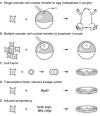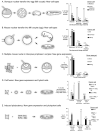Efficiencies and mechanisms of nuclear reprogramming
- PMID: 21047900
- PMCID: PMC3833051
- DOI: 10.1101/sqb.2010.75.002
Efficiencies and mechanisms of nuclear reprogramming
Abstract
The differentiated state of somatic cells is highly stable, but it can be experimentally reversed. The resulting cells can then be redirected into many different pathways. Nuclear reprogramming has been achieved by nuclear transfer to eggs, cell fusion, and overexpression of transcription factors. The mechanisms of nuclear reprogramming are not understood, but some insight into them is provided by comparing the efficiencies of different reprogramming strategies. Here, we compare these efficiencies by describing the frequency and rapidity with which reprogramming is induced and by the proportion of cells and level of expression in which reprogramming is achieved. We comment on the mechanisms that lead to successful somatic-cell reprogramming and on those that resist in helping to maintain the differentiated state of somatic cells.
Figures


References
-
- Amabile G, Meissner A. Induced pluripotent stem cells: current progress and potential for regenerative medicine. Trends Mol Med. 2009;15:59–68. - PubMed
-
- Asashima M, Grunz H. Effects of inducers on inner and outer gastrula ectoderm layers of Xenopus laevis. Differentiation. 1983;23:206–12. - PubMed
-
- Blau HM, Chiu CP, Webster C. Cytoplasmic activation of human nuclear genes in stable heterocaryons. Cell. 1983;32:1171–80. - PubMed
Publication types
MeSH terms
Substances
Grants and funding
LinkOut - more resources
Full Text Sources
Other Literature Sources
